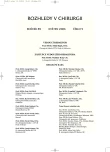Technical Aspects of the Liver Resection Procedure – Options for Combinations of Individual Methods
Technické aspekty resekce jater – možnosti kombinace jednotlivých metod
Úvod:
Narůstající důležitost jaterní resekce v léčení benigních a maligních hepatobiliárních onemocnění je dána i významným snížením operační mortality a pooperační morbidity v posledních letech jako výsledek zlepšení ve výběru nemocných, v chirurgické technice a v perioperační péči. Cílem sdělení bylo vyhodnocení kombinace novějších technik u jaterní transekce na základě vlastních zkušenosti a výsledků z recentních studií.
Materiál, metoda a výsledky:
V období od roku 1999 do května 2005 byla provedena na chirurgické klinice Fakultní nemocnice Královské Vinohrady v Praze resekce jater u 133 nemocných s benigním nebo primárním a sekundárním maligním nádorem. K transekci jater byl postupně použit od roku 1999 harmonický skalpel, utrazvukový disektor, vodní tryskový skalpel, bipolární diatermie, argonová koagulace a radiofrekvence. Disekce jaterní tkáně pomocí ultrazvukového disektoru nebo vodního tryskového skalpelu v kombinaci s harmonickým skalpelem nebo bipolární diatermickou koagulací snížila peroperační ztrátu krve u rozsáhlejších neanatomických resekcí jater. Tato metoda disekce byla použita i u některých „ centrálně“ lokalizovaných nádorů k neanatomické resekci. Benefit použité kombinace metod je dán dostatečnou koagulací a přerušením menších větví cév a žlučovodů v resekční linii bez zajištění intermitentního uzávěru přítoku krve do jater Pringleho manévrem. Radiofrekvence jako nová metoda ablace nádorů jater byla použita u anatomické i neanatomické resekce jater k předtransekční koagulaci jaterní tkáně k zajištění R0 resekce. Pooperační morbidita se vyskytla ve 14 % (19 nemocných). Do 30 dnů po operaci nebylo zaznamenáno úmrtí.
Závěr:
1. Použité techniky transekce jater pomocí ultrazvukového disektoru nebo vodního tryskového skalpelu jsou bezpečné metody resekce jater představující alternativy snižující krevní ztrátu. 2. K uzávěru s přerušením menších intraparenchymových větví cév a žlučovodů je alternativou harmonického skalpelu použití diatermické koagulace. 3. Kombinace techniky ultrazvukového disektoru nebo vodního tryskového skalpelu s harmonickým skalpelem nebo diatermickou koagulací zajišťuje resekci jater uzávěrem a přerušením cév a žlučovodů v resekční linii. 4. Použití radiofrekvence k pretransekční koagulaci jaterního parenchymu vede ke zmenšení krvácení při resekci a je metodou volby resekce centrálně lokalizovaných nádorů s omezením ztráty funkčního parenchymu.
Klíčová slova:
resekce jater – nová technologie – kombinace technik
Authors:
F. Vyhnánek; L. Denemark; V. Ducháč
Authors‘ workplace:
Chirurgická klinika Fakultní nemocnice Královské Vinohrady, Praha, přednosta doc. MUDr. J. Fanta, DrSc.
; Traumatologické centrum Fakultní nemocnice Královské Vinohrady, Praha, vedoucí lékař doc. MUDr. F. Vyhnánek, CSc.
Published in:
Rozhl. Chir., 2006, roč. 85, č. 5, s. 239-243.
Category:
Monothematic special - Original
Overview
Introduction:
The liver resection procedure as a treatment method of benign and malignant hepatobiliary disorders grows more important due to the fact, that its postoperative morbidity and mortality rates have been reduced, a result of the patients selection method, surgical techniques and perioperative care improvements. The aim of this report was to assess combinations of recent liver transsection techniques, based on the authors‘ own experience and results of recent studies.
Material, Methods and Results:
From 1999 to May 2005, in the Surgical Clinic of the Faculty Hospital Královské Vinohrady in Prague, the liver resection procedure was completed in 133 patients with benign or primary and secondary malignant tumors. In the liver transsection procedure, the following instrumentation was used, starting from 1999: harmonic scalpels, ultrasonographic dissectors, water jet scalpel, bipolar diathermia, argon coagulation and radiofrequency. The liver tissue dissection using the ultrasonographic dissector or the water jet scalpel in combination with the harmonic scalpel or bipolar diathemic coagulation, reduced the postoperative blood loss in extensive non-anatomical liver resections. This dissection method was also used in some “centrally“ located tumors for their non-anatomical resections. The benefit of the combination of the methods is based on sufficient coagulation and interruption of minor vascular branches and bile ducts in the resection line, without intermittent closure of the blood influx to the liver, using a Pringle manoeuvre. The radiofrequency, as a novel method for the liver tumors ablation, was used in anatomical and non-anatomical liver resections to coagulate the liver tissue prior to its transection prior to the R0 resection. The postoperative morbidity rate was 14% (19 patients). Within 30 postoperative days, no death was recorded.
Conclusion:
1. The above listed liver transsection techniques, employing the ultrasonographic dissector or water jet scalpel, are safe alternative liver resection methods, reducing the blood loss. 2. Diathermic coagulation is an alternative to the harmonic scalpel for intersecting minor intraparenchymatous vascular branches and bile ducts. 3. A combination of the ultrasonographic dissector technique or water jet scalpel with the harmonic scalpel or diathermic coagulation technique, aids the liver resection by closing and interrupting the vessels and bile ducts in the resection line. 4. Radiofrequency and pre-transsectional coagulation of the liver parenchyma reduces the bleeding during the resection procedure and is a method of choice in resections of centrally located tumors, reducing the loss of the functional parenchyma.
Key words:
liver resection – novel technology – combination of techinques
Labels
Surgery Orthopaedics Trauma surgeryArticle was published in
Perspectives in Surgery

2006 Issue 5
- Metamizole vs. Tramadol in Postoperative Analgesia
- Safety and Tolerance of Metamizole in Postoperative Analgesia in Children
- Metamizole in perioperative treatment in children under 14 years – results of a questionnaire survey from practice
- Obstacle Called Vasospasm: Which Solution Is Most Effective in Microsurgery and How to Pharmacologically Assist It?
Most read in this issue
- Laparoscopic Rectopexis
- Tracheal Tumor – A Case Review
- Percutaneous Cholecystostomy in Acute Cholecystitis – A Solution for Risk Patient Groups?
- Pancreatectoduodenectomy for Multiple Duodenal Diverticula. Case Report
